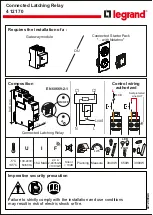
I N STA L L ATI O N
•
Westinghouse
I . L. 41- 1 33.28
OPE R A T I O N
•
M A I N TEN A N CE
I N S T R U C T I O N S
TYPE I RQ DI RECTIONAL OVERCU RRENT
NEGATIVE SEQUENCE RELAY
FOR GROU N D PROTECTION
C A U T I O N
Before putting the relay into service, re
move blocking from all the moving parts. Inspect the
relay and operate all elements by hand to be sure no
damage has occured during shipment.
A P P L I C A T I O N
The type IRQ is a directional overcurrent ground
relay in which the directional unit operates on neg
ative sequence current and voltage, and the over
current units operates on residual or ground current.
The negative sequence current and voltage are obtain
ed by means of self-contained negative sequence
filters connected between the directional unit and the
current and potenti al transformers.
The relay is intended for use at locations where
the present equipment or system conditions do not
permit the use of the conventional types of directional
ground relays operating entirely on residual current
and voltage.
At an ungrounded substation on grounded systems
where only two potential transformers are available,
or where the potential transformers are on the low
tension side of a wye-delta or delta-wye power trans
former bank, the type IRQ relay is applicable for
ground protection.
C O N S T R U C T I O N A N D O P E R A T I O N
The type IRQ relay consists of a directional
cylinder unit
(D)
operating on negative sequence quan
tities, negative- sequence current and voltage filters
an auxiliary switch (C& l), a time-overcurrent unit
(CO), an instantaneous overcurrent unit (I), and two
indicating contactor switches (ICS/1) and (ICS/T). The
principle component parts of the relays and their
location are shown in Figs.
1
and
2.
D i rectional U n it ( D )
The directional unit is a product induction cylin
der type unit operating on the interaction between the
SU PERSEDES I . L. 41 - 1 33 . 2A
*Denotes change from superseded i ssue
polarizing circuit flux and the operating circuit flux.
Mechanically, the directional unit is composed of
four basic components: A die-cast aluminum frame,
an electromagnet, a moving element assembly, and a
molded bridge.
The frame serves as the mounting structure for
the magnetic core. The magnetic core which houses
the lower pin bearing is secured to the frame by a
locking nut. The bearing can be replaced, if neces
sary, without having to remove the magnetic core from
the frame.
The electromagnet has two series-connected polar
izing coils mounted diametrically opposite one an
other; two series-connected operating coils mounted
diametrically opposite one another; two magnetic ad
justing plugs; upper and lower adjusting plug clips,
and two locating pins. The locating pins are used to
accurately position the lower pin bearing, which is
mounted on the frame, with respect to the upper pin
bearing, which is threaded into the bridge. The elec
tromagnet is secured to the frame by four mounting
screws.
The moving element assembly consists of a spiral
spring, contact carrying m ember, and an aluminum
cylinder assembled to a molded hub which holds the
shaft. The shaft has removable top and bottom j ewel
bearings.
The shaft rides between the bottom pin
bearing and the upper pin bearing with the cylinder
rotating in an air gap formed by the electromagnet and
the magnetic core.
The bridge is secured to the el ectromagnet and
frame by two mounting screws. In addition to holding
the upper pin bearing, the bridge is used for mounting
the adjustable stationary contact housing. The sta
tionary contact housing is held in position by a spring
type clamp. The spring adjuster is located on the
underside of the bridge and is attached to the moving
contact arm by a spiral spring. The spring adjuster
is also held in place by a spring type clamp.
EFFECTIVE A P R I L 1 966
www
. ElectricalPartManuals
. com














































